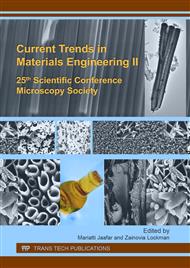p.33
p.38
p.42
p.46
p.50
p.54
p.58
p.62
p.66
Fabrication of Carbonate Apatite Based on Hydrothermal Reaction Using Freeze-Casted β-TCP Precursor
Abstract:
Carbonate apatite (CO3Ap) has similarity to biological bone in composition which is expected to induce excellent tissue response and osteoconductivity. CO3Ap with lower crystallinity also promotes more apatite absorption in vivo. This study aims to fabricate low crystallinity of carbonate apatite from β-TCP scaffold as precursor using hydrothermal treatment at 200oC. An interconnected structure of β-TCP scaffolds were fabricated by freeze casting method which immersed in 5 mol/L of disodium carbonate (Na2CO3) solution for hydrothermal with various days of treatment; 3, 5 and 7 days. The morphology of apatite transformed was investigated by scanning electron microscopy (SEM) while the crystallinity was measured by X-ray diffraction (XRD). The carbonate content and Ca/P ratio after hydrothermal were obtained by CHN analyzer and X-ray fluorescence (XRF), respectively. The results show that carbonate content higher than 11 wt% was obtained which is important for both cell adhesion and proliferation. The apatite structure in the form of needle-like crystal is also observed.
Info:
Periodical:
Pages:
50-53
Citation:
Online since:
September 2017
Authors:
Keywords:
Price:
Сopyright:
© 2017 Trans Tech Publications Ltd. All Rights Reserved
Share:
Citation:


